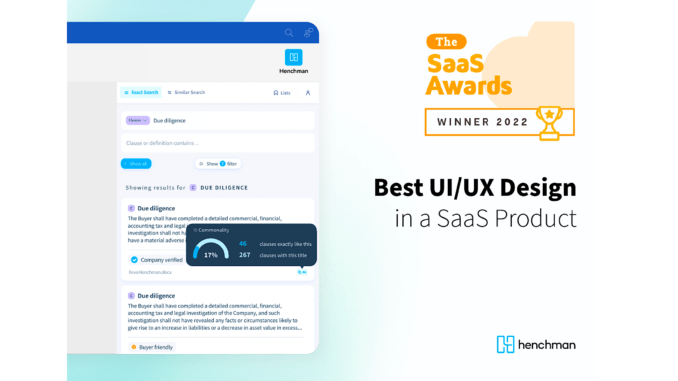
Contract drafting pioneer Henchman has been declared the winner of the ‘Best User Experience (UX), Best User Interface (UI) and Design Prize’ at the prestigious SaaS Awards.
This site doesn’t often cover prizes, but it’s important for the legal tech world to applaud good UI and UX because it’s central to the thesis that the best way to evaluate such products – and for these tools to be actually used by lawyers – is for people to enjoy utilising the product and feel they can easily get value from it.
UI/UX is not the entirety of that equation, but is a key part of it. So, congrats to Henchman, which is based in Belgium but has clients in several international markets including the UK, on being named the outright winner in this category for 2022.
Artificial Lawyer then asked the company: what was its UI/UX secret sauce? If their design approach is better than others, why is this?
This is how they replied: ‘When the founders of Henchman started working on the idea of their contract drafting technology in 2019, we conducted a great deal of qualitative and quantitative research.
‘The following product specifications formed our ‘Five Commandments’ when prototyping, and still are there when we are engineering today.
Henchman will be:
– plug & play.
– dummy-proof.
– work seamlessly within Microsoft Word.
– system agnostic.
– language agnostic.’
Henchman’s Co-Founder, Jorn Vanysacker, then noted: ‘From day one, the Henchman product and engineering team has been obsessed with creating the best User Experience for legal professionals, which translates into a technology that requires no setup from the end-user and is very intuitive to use.’
The company added that they focus a lot on product improvement through ‘agile two-week sprints, in-depth user workshops, and having dedicated product managers and product owners who act as a bridge between customers and engineering’.
Henchman’s CTO, Wouter Van Respaille, concluded: ‘Technology should work for the user, and not the other way around.’
And that perhaps sums up the core of what good UI/UX is all about, i.e. removing the effort from trying to use a tool – which is of course there because you are trying to remove ‘work’ from a process in the first place. The more ‘work’ you add to trying to use your tool, the more you undermine its value.
This has always been the catch with new technology. Often the new solution can be as complex as the old solution, it just uses a different approach – in this case via software.
The truly beneficial innovation is the stuff that breaks that pattern, that goes beyond creating an alternative approach which is not truly compelling, to providing something that ‘sells itself’ because it just so clearly and intuitively works, and where the desired output value can be reached very rapidly.
Of course, if this were easy then everyone would be doing it and companies like Apple (at least during its golden years under Steve Jobs) would be ten a penny – rather than extremely rare.
To conclude, anything that encourages better usability and improves time to value has got to be welcomed in the legal tech field, because that is what will really speed adoption by lawyers.